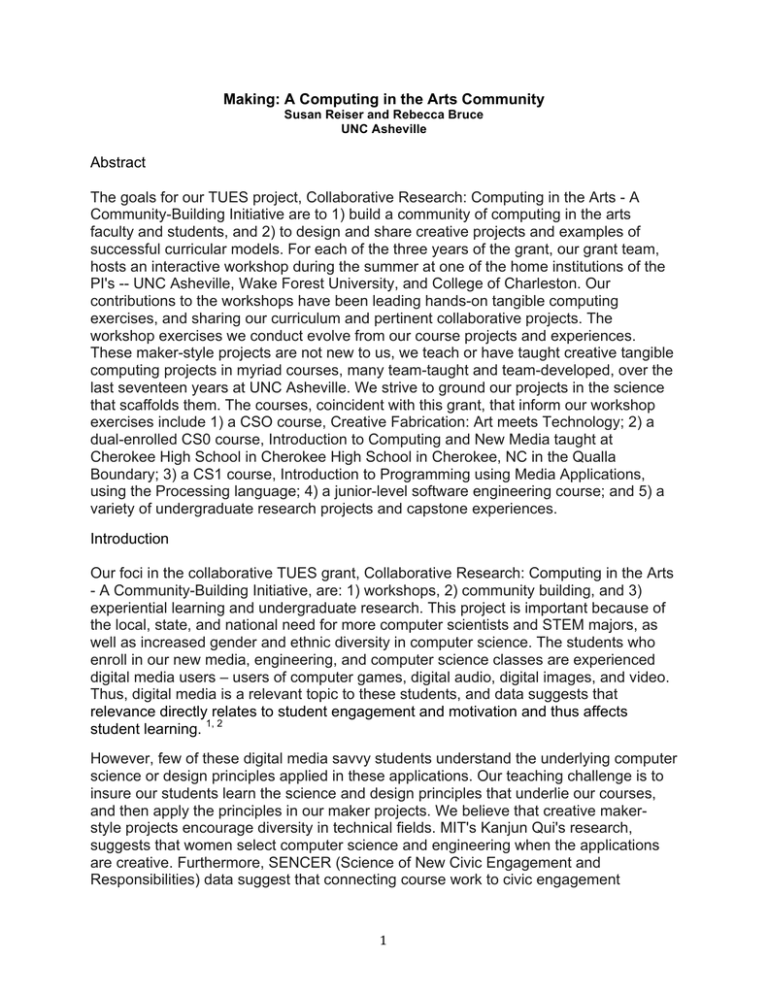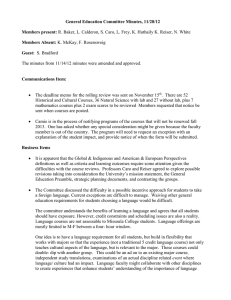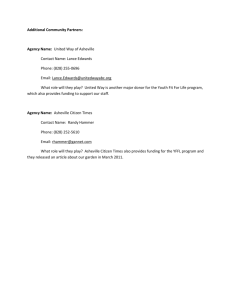Making: A Computing in the Arts Community Abstract The goals for
advertisement

Making: A Computing in the Arts Community Susan Reiser and Rebecca Bruce UNC Asheville Abstract The goals for our TUES project, Collaborative Research: Computing in the Arts - A Community-Building Initiative are to 1) build a community of computing in the arts faculty and students, and 2) to design and share creative projects and examples of successful curricular models. For each of the three years of the grant, our grant team, hosts an interactive workshop during the summer at one of the home institutions of the PI's -- UNC Asheville, Wake Forest University, and College of Charleston. Our contributions to the workshops have been leading hands-on tangible computing exercises, and sharing our curriculum and pertinent collaborative projects. The workshop exercises we conduct evolve from our course projects and experiences. These maker-style projects are not new to us, we teach or have taught creative tangible computing projects in myriad courses, many team-taught and team-developed, over the last seventeen years at UNC Asheville. We strive to ground our projects in the science that scaffolds them. The courses, coincident with this grant, that inform our workshop exercises include 1) a CSO course, Creative Fabrication: Art meets Technology; 2) a dual-enrolled CS0 course, Introduction to Computing and New Media taught at Cherokee High School in Cherokee High School in Cherokee, NC in the Qualla Boundary; 3) a CS1 course, Introduction to Programming using Media Applications, using the Processing language; 4) a junior-level software engineering course; and 5) a variety of undergraduate research projects and capstone experiences. Introduction Our foci in the collaborative TUES grant, Collaborative Research: Computing in the Arts - A Community-Building Initiative, are: 1) workshops, 2) community building, and 3) experiential learning and undergraduate research. This project is important because of the local, state, and national need for more computer scientists and STEM majors, as well as increased gender and ethnic diversity in computer science. The students who enroll in our new media, engineering, and computer science classes are experienced digital media users – users of computer games, digital audio, digital images, and video. Thus, digital media is a relevant topic to these students, and data suggests that relevance directly relates to student engagement and motivation and thus affects student learning. 1, 2 However, few of these digital media savvy students understand the underlying computer science or design principles applied in these applications. Our teaching challenge is to insure our students learn the science and design principles that underlie our courses, and then apply the principles in our maker projects. We believe that creative makerstyle projects encourage diversity in technical fields. MIT's Kanjun Qui's research, suggests that women select computer science and engineering when the applications are creative. Furthermore, SENCER (Science of New Civic Engagement and Responsibilities) data suggest that connecting course work to civic engagement 1 encourages participation by women and other underrepresented minorities.3 Accordingly, 50% of the New Media majors at UNC Asheville's are female as opposed to the approximately 12% female majors in Computer Science and 9% female majors in Engineering. While the cause of the gender disparity among UNC Asheville's departments is unknown, we know the standard hypothesis – math requirements – is false, because 46% of the Mathematics majors are female. Through this grant, we work towards establishing a community of computing in the arts practitioners. In annual workshops conducted in May, we share hands-on, creative, multidisciplinary projects as well as effective ways to teach the science grounding the projects and curriculum models. We believe the workshops benefit participating faculty, including ourselves, by providing professional development during the workshops and in post-workshop communication. Each workshop includes over 20 faculty members representing many disciplines and institutions across the country who share an interest in computing in the arts. We recruit participants at ACM's SIGCSE and through targeted mailings, online postings, and word of mouth. In both of the preceding workshops, we received more applicants than we could accept. We anticipate and hope that the 2016 workshop to be hosted at UNC Asheville will enjoy similar participation. Our grant is collaboration between the College of Charleston, Wake Forest University, and UNC Asheville. Each of our liberal arts colleges approaches computing in the arts differently, which allows us to present a smorgasbord of curricular options during the workshops. The College of Charleston offers a Computing in the Arts program within their Computer Science Department. Wake Forest University's Jennifer Burg teaches several Computing in the Arts styled courses within the Department of Computer Science. UNC Asheville has a separate major, New Media, which teaches computing in the arts themed courses; and additionally a variety computing in the arts courses are sprinkled throughout the liberal arts curriculum. Specifically discussed in this paper are the courses developed by Susan Reiser (New Media and Computer Science) and Rebecca Bruce (Engineering and Computer Science) that teach tangible computing and computing in the arts courses within the Department of Computer Science. We base our workshop exercises on the assignments, topics, and experiences from our courses. The computing in the arts themed classes that we teach at UNC Asheville provide us a venue in which to develop and implement maker style, creative tangible computing projects. Those classes that are coincident with this grant include CS0, CS1, upper level classes for majors, capstone and undergraduate research classes. All of the classes are UNC Asheville classes, and all but one are face-to-face classes held at the college campus. The exception is a CS0 course Reiser teaches once per year at Cherokee High School in Cherokee, NC in the Qualla Boundary (Eastern Cherokee Indian Reservation). Approach We are building a community of computing in the arts educators through our workshops and other presentations. The tangible computing materials we present in the workshops are based on projects we create for our classes and informed by student and faculty feedback. In this section, we detail several classes from which we draw materials for the 2 workshops. Throughout all of the courses, our project-based learning approach is consistent. We require 1) low stakes assignments targeting specific skills or knowledge required in a follow-up project, 2) project prototypes, 3) oral presentations, 4) written documentation, and 5) one or more projects that synthesize skills and background inquiry into the development of a creative product. The courses use a medley of project-based learning, studio-based learning, and the SENCER approach, teaching science through civic engagement. For example, our current co-taught course is a CS0 course, Creative Fabrication: Art meets Technology. Figure 1: Creative Fabrication Metal Pour, This is the third time we have taught the course, and 11/3/2015. the third iteration. The class satisfies UNC Asheville's ARTS and DIVERSITY general education requirements. The diversity requirement is met by focusing the fabrication projects through the lens of disability. We believe the theme is appropriate for two reasons: 1) a relatively large percentage of computer science majors self-identify as being disabled4, and 2) almost all of us will be disabled at some point in our lives. So far, we have not encountered a student who has not been touched by disability. In some cases they mention a disabled grandparent, and in some cases they self identify as being disabled. Some who self identify have observable disabilities; Figure 2: Creative Fabrication Critique, 12/3/2015. others reveal hidden or past disabilities. Students examine the ethics and fabrication of human enhancement and assistive technology. This semester we collaborated with sculpture professors Brent Skidmore and Jackson Martin, both faculty members in the Art Department. Working in teams of two, one computer science student and one art student, they developed assistive technology projects. Together they constructed 3D models using Autodesk's Fusion 360 and cast one part of the assembly in either bronze or aluminum using a lost-wax technique (really a lost-3D-print technique) as shown in Figure 1. Then individually, the students fabricated the final project. We taught the 3D modeling and printing, and the sculpture faculty taught the bronze and aluminum casting. The courses 3 Figure 3: From top right, clockwise: Cherokee High Students Decorating Cookies, 3D Printed Cookie Cutters, Bat Cutter in Action, Cookies, 12/18/2015. concluded with a joint critique and gallery exhibit. See Figure 2. In Reiser's CS0 course, Introduction to Computing and New Media, conducted at Cherokee High School, students create Scratch games based on Native American myths; electronic projects such as electronic origami and Arduino projects; 3D models and prints; and vector graphics projects. In the fall 2015 semester we ended the course by printing custom cookie cutters using their Scratch animation characters and then "fabricating" cookies with the cutters. See Figure 3. In Reiser's CS1 course, Introduction to Programming using Media Applications, the class developed games in Processing5 for 7th graders around topics from the NC Math Standard Curriculum that were suggested by area middle school teachers. North Carolina teacher-certified UNC Asheville faculty members, Judy Beck (Physics) and Cathy Whitlock (Mathematics) served as subject matter experts and project collaborators. Whitlock tested the completed games with approximately 100 local middle school students. Reiser's software engineering students began their semester analyzing the 100 middle school evaluations and conducting code reviews of the games. Then the class worked to improve or build new games for the middle school students using Agile methods. While our experiences have been overwhelmingly positive, we have encountered challenges to which we have responded or are responding to in our next class offering. As is typical with initial project implementations in the classroom or in industry, its shortcomings become apparent in deployment. What works well in preliminary testing by the instructors, may need tweaking to be successful in the classroom. In particular, we need to better interweave project management into the CS0 and CS1 courses to minimize last minute, slapdash efforts. We need to better define craftsmanship, to show examples of and teach the students to identify good and bad craftsmanship, and to clearly explain how craftsmanship is part of their grade. In the first workshop, the attendees did not have enough time to share their expertise. Therefore, in the second workshop at the College of Charleston, Professor and PI Bill Manaris divided into the attendees into self-selected teams. The teams brainstormed collaborative projects and ideas for future work, which they then presented to the group. We will repeat this very successful exercise in the 2016 workshop in May at UNC Asheville. One example of collaborative work spawned by the workshop is Courtney Starrett's project with Reiser. Starrett, an Assistant Professor of Art at Seton Hall University, is currently fabricating approximately 200 Figure 4: Production of Data Informed silicon rubber doilies with patterns that are informed Doilies in Starrett's Studio, 1/4/2016 by data – what Starrett refers to as data aesthetization, see Figure 4. The designs originate from a customizable program written 4 and iteratively refined by Reiser. Starrett selects input data sets and refines the outputted vector curves to 3D print her doily molds. Starrett will exhibit the resulting installation, a tangible outcome of our work, in Clever on Sunday as part of the exhibition at the Dorsky Museum in New Paltz, NY.6 Results Our outcomes do not surprise: students and faculty members enjoy hands-on projects. Having end-users other than ourselves is a valuable experience even in a CS0 or CS1 course. Working with our colleagues in Art taught us many things – including metal casting -- and we appreciate the professional development inherent in multidisciplinary teaching collaborations. Bruce, Reiser and their Art colleagues, Jackson and Skidmore will collaborate again this semester in their Creative Fabrication and sculpture classes. We have enrolled increasing numbers of Cherokee High students in our CS0 course, although the class size is still small. Starrett and Reiser continue to work on follow-up projects. And, finally, we look forward to our last grant-funded May workshop at UNC Asheville May 18-20, 2016. Our project directly impacts faculty and students: the faculty attending the NSF-funded workshops, the faculty who utilize the online materials, and the students who enroll in computing in the arts courses and programs informed by the relevant projects and faculty. We have disseminated our work through traditional journals and conferences 7,8,9,10 ; as examples of SENCERized classes in posters11, 12, 13 and a presentation14 at SENCER sponsored conferences, at the Gulf South Summit15, and at invited SENCER workshops at the University of Georgia (fall 2014) and Kentucky Compact (fall 2015); and at The Humanities and Technology Conference.16 We believe in maker-style projects and multidisciplinary computing in the arts courses. When coupled with an explicit connection to humanity (e.g. assistive technology and disability), they are an effective way to demonstrate the relevance of the computer science and design principles. Relevance can serve to motivate students. We hope to continue to see increased numbers of women and other underrepresented minority groups in our creative computing classes. And we plan to continue to learn from and share our maker projects with other faculty—the multidisciplinary computing in the arts community fostered by this grant. Acknowledgement This paper is based upon work supported by the National Science Foundation under TUES grant number 1323610. We thank our collaborating PIs: Jennifer Burg, Bill Marinus, and Rene McCauley; and colleagues: Judy Beck, Sam Julian, Jackson Martin, Sara Sanders, Brent Skidmore, Courtney Starrett, Matthew West, and Cathy Whitlock. References 1. Frymier, A. & Schulman, G. 1995. “What’s in it for me?” Increasing content relevance to enhance students’ motivation. Communication Education, 44, 40-50. 5 2. Martin, A. & Dowson, M. 2009. Interpersonal relationships, motivation, engagement, and achievement: Yields for theory, current issues, and educational practice. Review of Educational Research, 79, 327-365. 3. SENCER, Viewbook 2009, http://sencer.net/About/pdfs/Viewbook_web_Sept2009.pdf 4. NSF, "Major field of study of undergraduates, by disability status: 2012," ed: National Science Foundation, 2012. 5. Reiser, S., Whitlock, C. & Beck, J. 2015. seekingstem.unca.edu. 6. Starrett, C. (Reiser, S. collaborator). Clever on Sunday. In Made for You: New Directions in Contemporary Design, Jennifer Scanlan (curator), Samuel Dorsky Museum of Art, SUNY New Paltz, (Feb. 6-July 10, 2016). 7. Reiser, S., Bruce, R., Burg, J., Manaris, B., & McCauley, R. 2016. Birds of a Feather Meeting: Fostering Computational Creativity through Computing in the Arts: Community of Educators, Abstract to be published in the 2016 Proceedings of ACM SIGCSE, Memphis, TN, Mar 3-7, 2016. 8. Reiser, S. & Bruce, R. 2016. NSF Showcase: Computing in the Arts: Multidisciplinary Making, To occur at ACM SIGCSE, Memphis, TN, Mar 7, 2016. 9. Bruce, R. & Reiser, S. 2015. Challenging Notions Of Being Normal In The CS Classroom. J. Comput. Sci. Coll. 31, 1 (November 2015). 10. Reiser, S. & Bruce, R. Cultivating Creativity (and Majors) with Computational Craft, 2014 Proceedings of IEEE Southeastcon, Lexington, KY, April 4-7, 2014. 11. Reiser, S., Beck, J., Whitlock, C., (2015) Poster: User-Centered Design: Software engineering for 7th grade users, SENCER Center of Innovation South Regional Meeting, UNC Asheville, Asheville NC, Oct 15, 2015. 12. Reiser, S., Whitlock, C., & Beck, J. (2015) Poster: Back to 7th Grade: A progress report on Seeking STEM's pilot, SENCER Summer Institute, WPI, Worcester MA, Aug 1, 2015. 13. Beck, J., Reiser, S., & Whitlock, C., (2014) Poster: Seeking STEM: A collaboratively-designed digital scavenger hunt for middle school students, SENCER DC Symposium, Sept 30, 2014. 14. Silver, P., Reiser, S., & Bruce R. (2015) Workshop: Connecting Computer Science to Society: Building a Community of Educators, SENCER Summer Institute, WPI, Worcester MA, Aug 2, 2015. 15. Reiser, S. & Bruce, R. Getting Started with Computer Science and SENCER with Creative Fabrication, A Presentation given as part of the SENCER Workshop at the Gulf South Summit, Mar 27, 2014. 16. Reiser, S. & Bruce, R. TALK session, Building a community of computing in the arts educators. MAKE session, Electronic Origami. The Humanities and Technology Camp, NYC, Feb 9, 2015. 6 Biographies Susan Reiser and Rebecca Bruce teach at UNC Asheville, North Carolina's public liberal arts college located in the mountains of western North Carolina. Susan is a lecturer in the Departments of Computer Science and New Media and Associate Dean of Natural Sciences. She has been a member of the New Media program since its inception in 1998 and served for over ten years as the program’s Associate Director. Rebecca is a professor in the Departments of Computer Science and Engineering and serves as the Associate Director of the Mechatronics Engineering Program. Before teaching at UNC Asheville, we both worked in industry where we saw firsthand the importance of teamwork, project management and design, and effective communication. Our interests and publications link computer science, design, and creativity with digital media and tangible computing. Over the last seventeen years, we have codeveloped many courses with that theme, e.g. Creative Fabrication: Art Meets Technology. The course satisfies UNC Asheville's general education requirement in diversity because of its focus on disability and assistive technology. We work to include civic and societal issues in our classes, which dovetails with Susan's role as the Co-Director of the SENCER (Science Education for New Civic Engagement and Responsibilities) Center of Innovation South. 7


